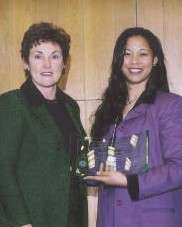Tasha Inniss
Tasha Rose Inniss is an American mathematician and the Director of Education and Industry Outreach for the Institute for Operations Research and the Management Sciences (INFORMS).
Tasha Inniss | |
|---|---|
 Jane Garvey (left) presents Tasha Inniss with an FAA Student-of-the-Year award in 2002 | |
| Alma mater | Xavier University of Louisiana University of Maryland, College Park |
| Scientific career | |
| Institutions | Trinity Washington University Spelman College |
| Thesis | Stochastic Models for the Estimation of Airport Arrival Capacity Distributions (2000) |
Early life and education
Inniss was born in New Orleans and grew up without a father.[1] She became interested in mathematics in fourth grade, and decide she would study it as a freshman in high school.[2] She studied mathematics at Xavier University of Louisiana, graduating summa cum laude.[3] In 1992 she was listed in the Who's Who Among Colleges and Universities for her academic achievements.[1] She earned a master's degree in Applied Mathematics from Georgia Institute of Technology.[4]
She moved to the University of Maryland for her PhD, funded by the David and Lucile Packard Foundation.[1][3][5][6] In 2000, Inniss became the first African American woman to obtain a Ph.D. from the University of Maryland, together with Sherry Scott and Kimberly Weems.[7] Her dissertation was Stochastic Models for the Estimation of Airport Arrival Capacity Distributions. She was part of the National Center of Excellence for Aviation Operators and advised by Michael Owen Ball.[4][8] Her brother, Enos Inniss, also completed his PhD in 2000.[1]
Research and career
In 2001 she was appointed the Clare Boothe Luce Professor of Mathematics at Trinity Washington University.[1] Her doctoral thesis described programming methods to calibrate models to estimate airport capacity.[9] She remains a consultant for the Federal Aviation Administration.[10]
She joined the department of mathematics at Spelman College in 2005 as an assistant professor.[11][12][13]
Throughout her career she has worked to recruit, support and mentor underrepresented minority students.[14][15][16][17] She led a National Science Foundation project that looked to increase the quality and quantity of underrepresented minorities matriculating and completing doctoral degrees.[18] She has contributed to the EDGE Foundation (Enhancing Diversity in Graduate Education) program.[19]
In 2017 she joined the Institute for Operations Research and the Management Sciences as Director of Education.[4]
Inniss' work earned her recognition by Mathematically Gifted & Black as a Black History Month 2017 Honoree.[20]
References
- "Underrepresented Minorities in Science: A Statistical Anomaly: The Story of an African-American Woman Battling the Odds to Become a Mathematician". Science | AAAS. 2001-03-02. Retrieved 2018-05-05.
- Case, Bettye Anne; Leggett, Anne M., eds. (2005). Complexities : women in mathematics. Princeton, N.J.: Princeton University Press. ISBN 978-1400880164. OCLC 949753960.
- "Student Essay Contest: 2001 Results". awm-math.org. Retrieved 2019-02-24.
- INFORMS. "INFORMS adds new Director of Education and Industry Outreach to Leadership Team". INFORMS. Retrieved 2018-05-05.
- "Delta SEE: About Us". www.deltasee.org. Retrieved 2018-05-05.
- "Packard Foundation Graduate Scholars Program: HBCU Directory". ehrweb.aaas.org. Retrieved 2018-05-05.
- "The First Three African American Women to Receive Doctorates in the Mathematics Department". www.math.umd.edu. Retrieved 2018-05-05.
- Tasha Inniss at the Mathematics Genealogy Project
- Tasha, Inniss (2001). "Stochastic Models for the Estimation of Airport Arrival Capacity Distributions". Cite journal requires
|journal=(help) - "Tasha R. Inniss". Duchess International Magazine. Retrieved 2018-05-05.
- Inniss, Tasha R.; Lee, John R.; Light, Marc; Grassi, Michael A.; Thomas, George; Williams, Andrew B. (2006-11-10). Towards applying text mining and natural language processing for biomedical ontology acquisition. ACM. pp. 7–14. doi:10.1145/1183535.1183539. ISBN 978-1595935267.
- "Interviewees". livingthinkers. Retrieved 2018-05-05.
- Muicahy, Colm (2017). "A Century of Mathematical Excellence at Spelman College". A Century of Mathematical Excellence at Spelman College. Atlanta University Center, Robert W. Woodruff Library. doi:10.22595/scpubs.00013.
- L., Joiner, Lottie (2003-01-05). "Success to the Third Degree". Black Issues in Higher Education. 18 (11). ISSN 0742-0277.
- ""HBCUs' Relevance in Diversifying the STEM Workforce" by Carter-Johnson, Frances; Inniss, Tasha; Lee, Mark E. - Diverse Issues in Higher Education, Vol. 35, Issue 2, February 22, 2018 | Online Research Library: Questia". www.questia.com. Retrieved 2018-05-05.
- "Against the Odds: Three African-American Women to Discuss the Road to Math Ph.D.s". Office of News & Media Relations | UMass Amherst. Retrieved 2018-05-05.
- Review, Peer (2014-04-29). "Who Is Minding the Gap?". Association of American Colleges & Universities. Retrieved 2018-05-05.
- "NSF Award Search: Award#1249262 - Bridge to the Doctorate at UMCP, 2012-2014". www.nsf.gov. Retrieved 2018-05-05.
- "EDGE 2009". THE EDGE PROGRAM. Retrieved 2018-05-05.
- "Tasha Inniss". Mathematically Gifted & Black.